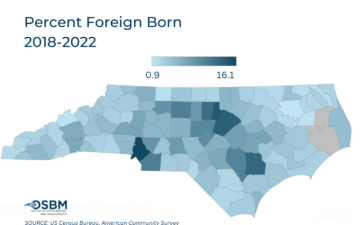North Carolina: Census 2020 Real-Time Response Rates – Week ending May 10 (.pdf)
View All County-Level Response Rates –
Week ending May 10
Key takeaways for week ending May 10
- North Carolina rises two rankings to 35 out of 50 states and DC. This is its highest ranking since reporting began two months ago. NC now has a response rate of 54.5%. Minnesota (68.7%) was the top responding state in the nation for the sixth week.
- The response rate gap between North Carolina and the United States is declining. Two weeks ago, 48.5% of households in North Carolina responded to the Census vs. 53.2% of households in the nation, representing a gap of 4.7 percentage points. As of May 10th, it had declined to 4 percentage points – 54.5% of households in NC vs. 58.5% of households nationwide.
- Union County now exceeds 2010 NC state response rate. 66.2% of households have responded to the census in Union County, the state’s top-responding county. This now exceeds North Carolina’s final 2010 response rate by 1.4 percentage points.
- North Carolina passes Mississippi in self-response rate. North Carolina has now passed two southeastern states with previously higher self-response rates: Arkansas and Mississippi. There are now six southeastern states which exceed North Carolina as of May 10th: Virginia (63.5%), Kentucky (62.2%), Tennessee (58.3%), Alabama (56.5%), Florida (56.1%), and Georgia (54.6%).
- The average response rate for tracts with the smallest share of young children now exceeds 50% of households. As of May 10th, 52.3% of households have responded in tracts where less than 4.1% of the population is ages 0-4. However, this week represents the largest gap between this tract quartile’s response rate and the state overall self-response rate: 2.2 percentage points.
- Tracts with the smallest share of foreign-born residents now have an average response rate exceeding 50%. In tracts where less than 2.9% of the population was foreign-born, an average of 50.4% of households have responded to the Census. This tract quartile’s response rate is 4.1 percentage points below the state – a minor decline from a gap of 4.2 percentage points last week.
- Tracts with the largest minority populations have not met 50% benchmark. As of May 10th, an average of 47.6% of households have responded in tracts where over 50% of the population is non-White. This represents a gap of 6.9 percentage points from the state self-response rate, the highest since reporting began.
- Tracts with the lowest access to high-speed internet have not met 50% benchmark. An average of 46% of households have responded in tracts where over 31% of households lack access to high-speed internet. This represents a gap of 8.5 percentage points from the state self-response rate — a small decline from its peak of 8.6 percentage points last week.
Last updated: 5.11.20


